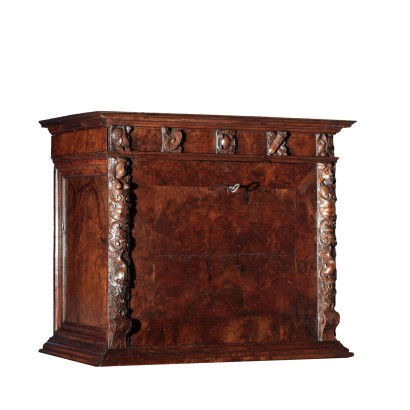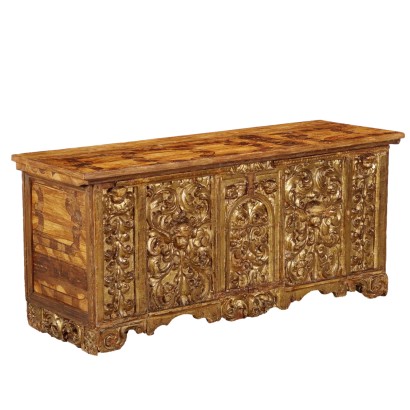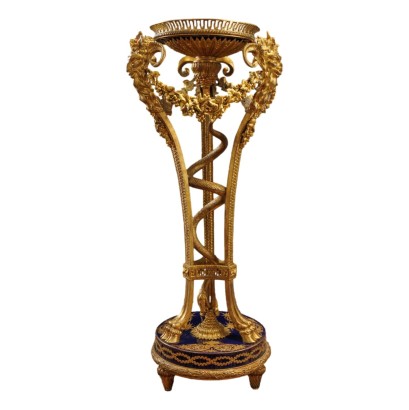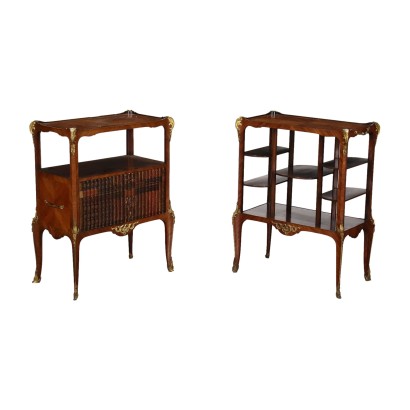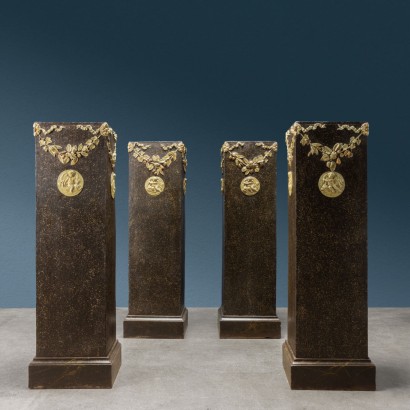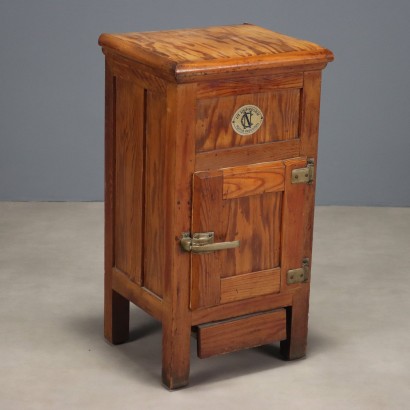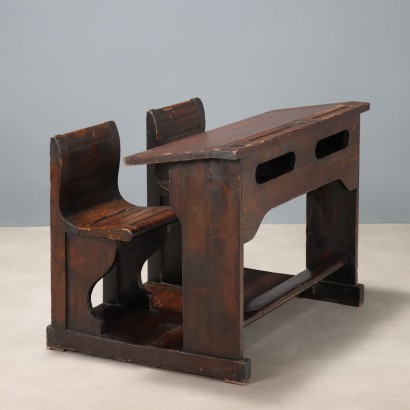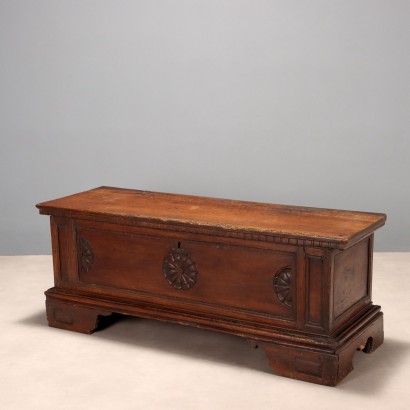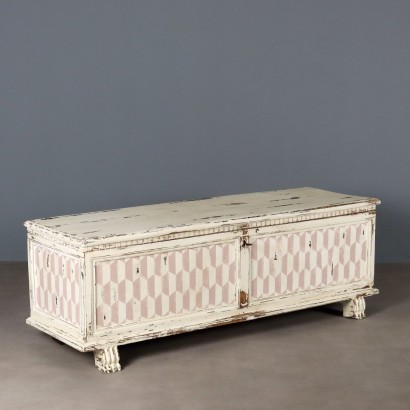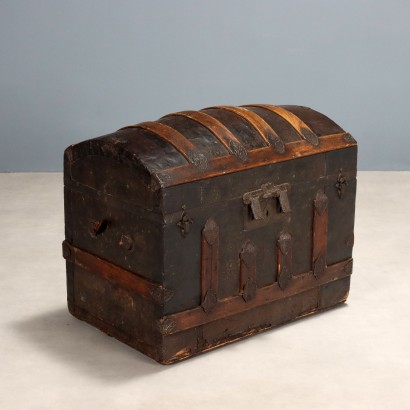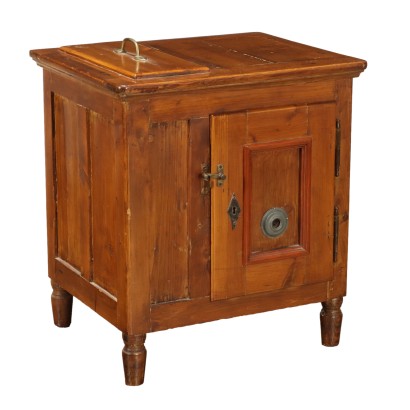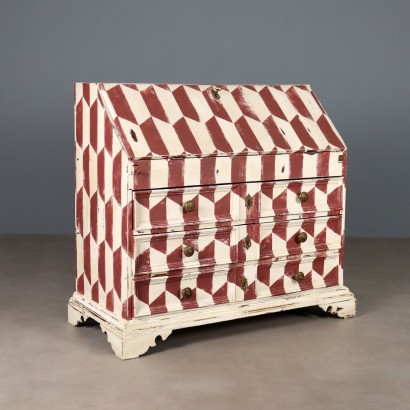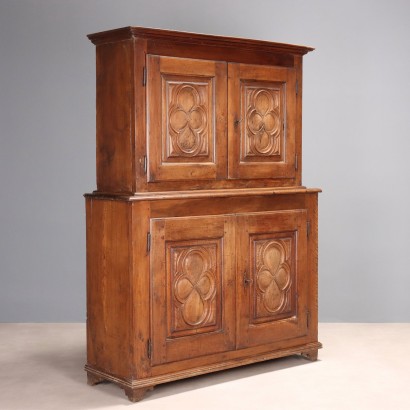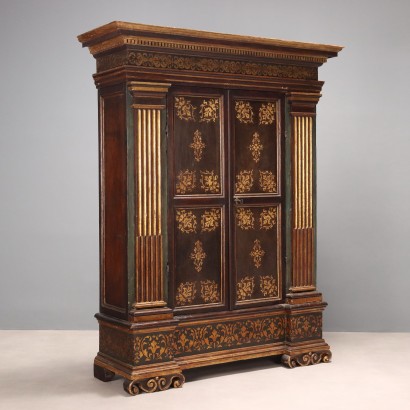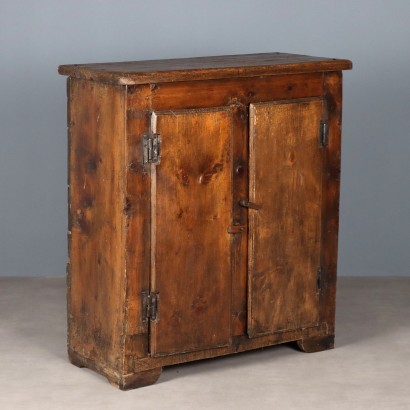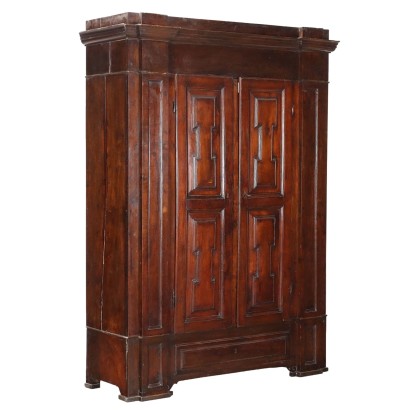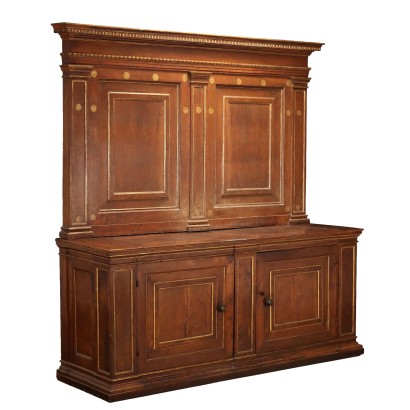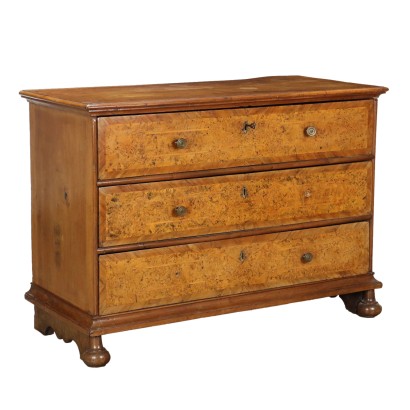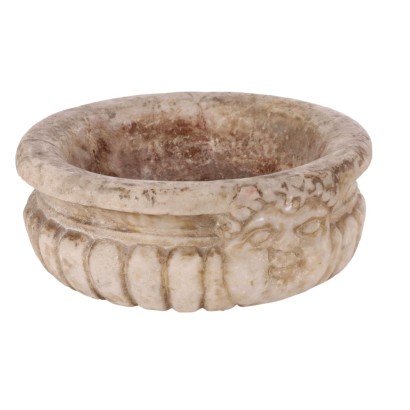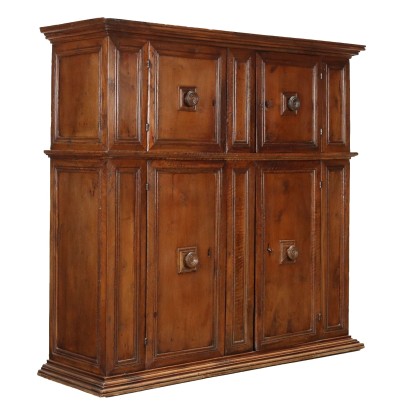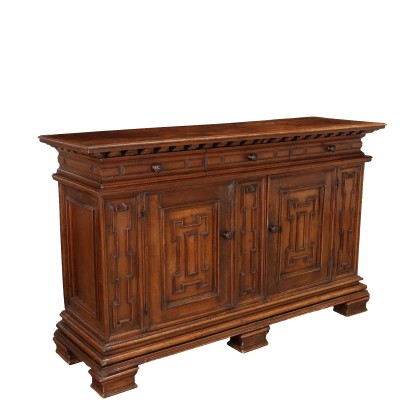Cabinet Walnut Italy XVI-XVII Century
Features
Age: 17th Century / 1601 - 1700 , 16th Century / 1501 - 1600
Origin: Toscana, Italy
Description
Walnut burl veneered cabinet, the uprights on the front, also in walnut wood, are richly carved: starting from the bottom there is a shelf in the shape of a leafy volute, surmounted by a fish, a dolphin according to the imagination of the time, and again from a grotesque mask. In the upper part there is instead a caryatid, in the left upright, while in the right one a telamon, both with facial features that recall the tradition of grotesque masks. The band below the top sees the alternation of reserves veneered in briar with small carved pieces: in the lateral ones there are two profiles of warriors with helmets on their heads, then there are two pieces with weapons, a shield and a quiver of arrows; in the center, finally, an oval coat of arms, without however any identifying elements. The front is occupied by a large opening flap door veneered in briar inside, hiding a chest of drawers consisting of twelve small drawers and two side doors; they are all decorated with carved briar frames. The wrought iron lock is hidden on the outside, but visible on the inside of the door; it has the characteristic lily shape, echoed in the door hinges.
Product Condition:
Product in fair condition showing some signs of wear.
Dimensions (cm):
Height: 61
Width: 73,5
Depth: 78,5
Additional Information
Notes historical bibliographic
The cabinet from Tuscany belongs to a less known and widespread type in this geographical area. In fact, the wooden cabinets inlaid with semi-precious stones are more well known, certainly derived from the famous production linked to the tradition of the Opificio delle Pietre Dure. Our cabinet is in fact entirely made of wood and even the decoration is entrusted to this material. The sides, the top, the front door (also on the inside) are entirely veneered in walnut briar; even the front of the small drawers and of the internal doors is in briar, worked in the solid wood in the case of the frames. This particular cut of the walnut, with a marked and lively vein, has, in fact, a great ornamental effect that enriches the surface of the cabinet. Also interesting are the uprights and small knobs placed in the band under the top, in carved walnut. The iconographic model to which they refer are the grotesques, an ornamental typology that spread from the end of the fifteenth century, but continued and reused also throughout the sixteenth century and the following century. In particular the masks, monstrous animals, caryatids and telamons with grotesque features had a long survival in the plastic type decoration. Very interesting, in our cabinet, is the physiognomy of the faces of the caryatid and the telamon, highly typed and completely characteristic. Even the warriors, the weapons and the coat of arms in the band below the floor are fully part of the iconographic panorama derived from the grotesques. Certainly these subjects are not found only in Tuscan production, but also in that of northern Italy: the Bergamo carvings are well known which, albeit in different ways, take up grotesque masks and caryatids. For our cabinet, as already mentioned at the beginning, it is more difficult to find precise feedback, even if some echoes can, in our opinion, be recognized in works even several years earlier. These include the lower part of the large lectern in Santa Maria Novella in Florence, built by Baccio d'Agnolo between 1491 and 1496.Age:
17th Century / 1601 - 1700
17th Century / 1601 - 170016th Century / 1501 - 1600
16th Century / 1501 - 1600Main essence:
Walnut
Walnut wood comes from the plant whose botanical name is juglans regia , probably originally from the East but very common in Europe. Light or dark brown in color, it is a hard wood with a beautiful grain, widely used in antique furniture. It was the main essence in Italy throughout the Renaissance and later had a good diffusion in Europe, especially in England, until the advent of mahogany. It was used for solid wood furniture and sometimes carvings and inlays, its only big limitation is that it suffers a lot from woodworm. In France it was widely used more than anything else in the provinces. In the second half of the eighteenth century its use decreased significantly because mahogany and other exotic woods were preferred.Poplar
Essence considered "poor", it is a white wood, with yellowish or greyish shades, light and tender, which is easily damaged. It is used for rustic furniture or in the construction of furniture. The most valuable use it has had in the history of furniture is in Germany, in the 19th century, for veneers and inlays in the Biedermeier period.Other customers have searched:
Approfondimenti
Per saperne di più sulle cassapanche, sbricia i nostri approfondimenti su FineArt:Un importante cassone italiano del XVI secolo
Un cassone pirografato veneto, di fine XVI
Lussuosi bauli Luis Vuitton del 1925
Il dizionario dell'antiquariato – Pastiglia
Sull'antiquariato in generale dai un'occhiata anche a
Classic Monday: da un pezzo dei nostri magazzini alla storia dell'antiquariato
L'antiquariato dalla A alla Z: il Dizionario dell'Antiquariato
Il dizionario dell'antiquariato - Lastronatura
Il dizionario dell'antiquariato - Mascherone
Il dizionario dell'antiquariato - Natura morta
Il dizionario dell'antiquariato - Opificio
Il dizionario dell'antiquariato - Pastiglia
Il dizionario dell'antiquariato - Savonarola
Il dizionario dell'antiquariato - Rosone
Se ti interessano i mobili d'antiquariato Scopri qui tutte le presentazioni dei prodotti d'antiquariato più belli, eleganti e preziosi su FineArt by Di Mano In Mano
Leggi di più
Sull'antiquariato in generale dai un'occhiata anche a:Antiquariato: una sezione per raccontare i mobili antichi che sono arrivati fino ai giorni nostri.
Classic Monday: da un pezzo dei nostri magazzini alla storia dell'antiquariato
L'antiquariato dalla A alla Z: il Dizionario dell'Antiquariato
Il dizionario dell'antiquariato - Lastronatura
Il dizionario dell'antiquariato - Mascherone
Il dizionario dell'antiquariato - Natura morta
Il dizionario dell'antiquariato - Opificio
Il dizionario dell'antiquariato - Pastiglia
Il dizionario dell'antiquariato - Savonarola
Il dizionario dell'antiquariato - Rosone
Intaglio barocco con motivo a ricciolo
Infine, dai un'occhiata alle nostre rubriche di divulgazione sulla storia delle arti decorative e d'arredo:
Epoche
Lavorazioni e tecniche
Mostre ed Eventi
Protagonisti
Product availability
Immediate availability
Ready for delivery within 2 working days from ordering the product.

